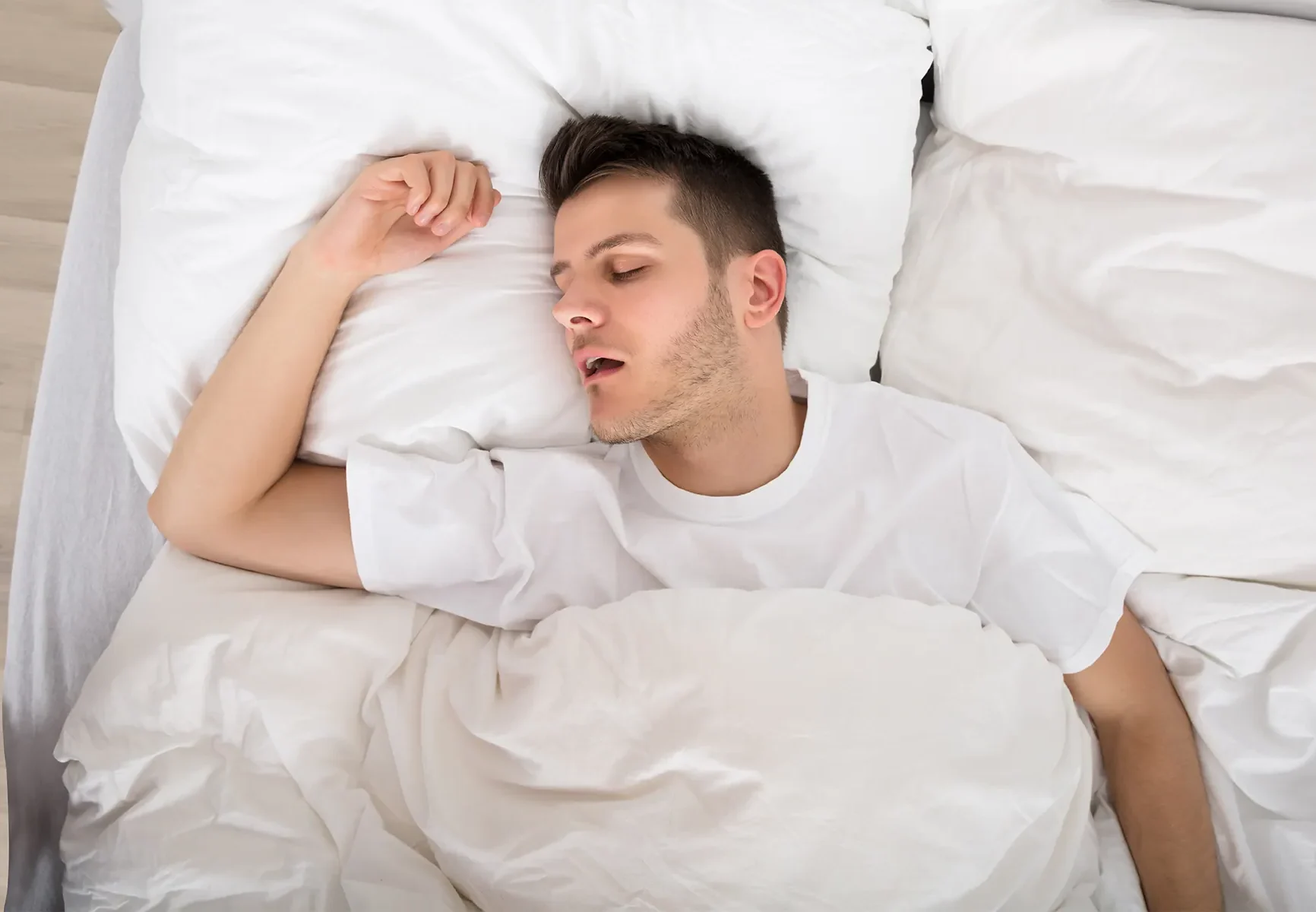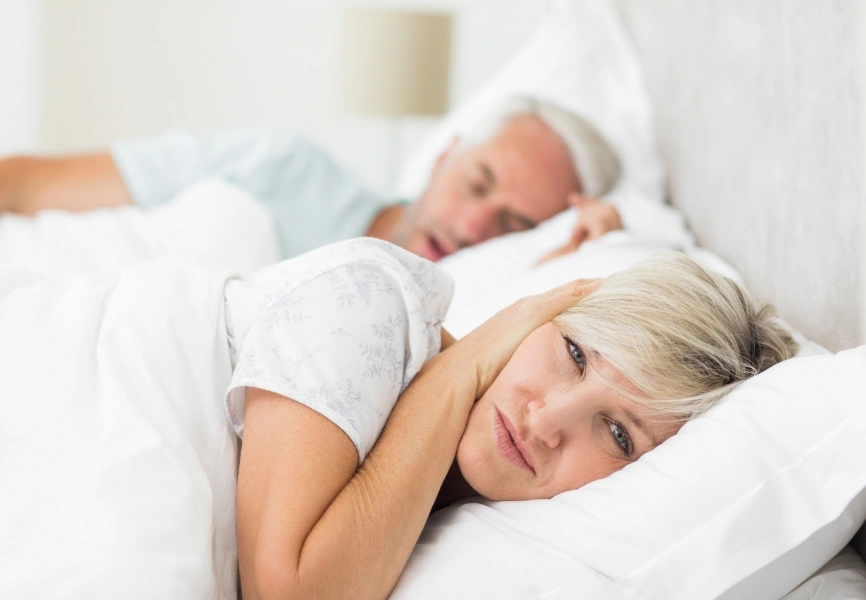Dr. Shawn Allen has either authored or reviewed and approved this content.
Page Updated:Breathe better, sleep better, feel better!
Snoring
Up to
Trusted Source
Treatment Options for Adults with Snoring
American Academy of Otolaryngology–Head and Neck Surgery Foundation
Go to Source
45% of men and 30% of women snore regularly
. Snoring is a sleep disorder that is more than an annoyance for bed partners: chronic snoring may be a sign of obstructive sleep apnea (OSA), and it may also be
Trusted Source
Diagnosis and treatment of snoring in adults-S2k Guideline of the German Society of Otorhinolaryngology, Head and Neck Surgery
Stuck BA, Dreher A, Heiser C, Herzog M, Kühnel T, Maurer JT, Pistner H, Sitter H, Steffen A, Verse T
Go to Source
connected to other serious conditions
. Houston area Sinus Specialist Dr. Shawn Allen is a fellowship-trained rhinologist and Board-Certified Otolaryngologist (ENT) who can diagnose the causes of snoring and provide effective treatments.

What Causes Snoring?
Simply put, snoring is the sound made when tissue around the airway vibrates during sleep. When air moves against these tissues at the back of the throat, it causes them to
Trusted Source
Snoring
American Sleep Apnea Association
Go to Source
flutter and produce noise
similar to a flag on a windy day.
People snore during sleep because of narrowing at two areas in the upper airway:
- The “floppy tube” portion, which involves relaxation of muscles that normally keep the throat open such as the tongue and soft palate.
- The “rigid tube” portion, which includes the nasal cavities and is impacted by septal deviations and enlarged turbinates that narrow and speed up airflow through the nose.
Other fixed obstructions may include enlarged tonsils and adenoids, particularly in children or adults with severe allergies. Additional factors may occasionally worsen snoring, such as respiratory illnesses that worsen congestion and sedating medications or alcohol that further relax the throat. The narrower the upper airway, the faster the air has to move through the “tubes” of the nose and throat causing turbulence and increasing the “flutter” effect, leading to louder snoring.
Snoring – Causes, Evaluation, and Treatment – an ENT Surgeon’s Perspective

Symptoms of Snoring
The most obvious symptom of the sleep disorder of snoring is bothersome noise and the impact that noise has on bedpartners. Additional symptoms of snoring may include:
- Daytime sleepiness
- Morning headaches
- A dry or sore throat in the morning
- Trouble focusing or concentrating
- Weight gain
- Confusion when awakening in the night
-
Trusted Source Snoring Cleveland Clinic Go to Source Moodiness
Risk Factors for Snoring
It is common for people to snore when they have a cold, respiratory infection, or allergies. Risk factors that
Trusted Source
Snoring
Johns Hopkins University
Go to Source
may lead to chronic snoring
include:
- Obesity
- Alcohol consumption
- Swelling of the uvula or soft palate
- Pregnancy
- Swollen soft tissues such as the tonsils, tongue, or adenoids
- Low muscle tone in the throat, mouth, or nose
- Deviated septum
- Structural issues in the mouth, nose, face, or throat
- Use of sleeping medications or antihistamines
- A tongue that is too large for the mouth

How is Snoring Diagnosed?
Most snorers are made aware of their condition by their bed partner. There are also apps that can monitor for snoring and track its frequency while you sleep, such as SnoreLab. Occasional snoring is less likely to represent a significant problem with breathing; however, snoring every night may be a sign of significant problems and should be evaluated further.
Dr. Allen evaluates the nose and the throat for signs of narrowing and obstruction using a combination of nasal endoscopy and/or CT imaging in the clinic. He will determine if a sleep study is needed, and make recommendations as to what treatments might improve breathing and alleviate snoring.
A sleep study can usually be conducted at home, though certain patients may require an in-lab sleep study. During a sleep study, patients wear a series of monitors that measure:
- Total sleep time
- Sleep efficiency
- Stages of sleep
- Eye movements
- Body position
- Movements and body position
- Heart rate
- Awakenings and arousals
- Respiratory patterns
-
Trusted Source Polysomnography Mayo Clinic Go to Source Blood oxygen levels
Treatments for Snoring
There are a number of treatment options available to people who struggle with chronic snoring. The most successful interventions target and correct nasal obstruction, such as septoplasty and turbinate reductions; however, there are options that directly address the soft palate and tongue when needed. Patients with enlarged tonsils and adenoids may require surgical removal of these structures as well. When you attend your snoring consultation with Dr. Allen, he will conduct an examination (and possibly order a sleep study), then recommend the most appropriate treatment for your unique needs.
Septoplasty
Nasal cavity is divided into two nostrils by the septum, a structure made of bone and cartilage. When the septum is deviated, or crooked, it can impede breathing through the nose and lead to snoring. A septoplasty is an endoscopic surgical procedure performed to straighten a deviated septum.
Inferior Turbinate Reduction
Turbinates are small bony structures located on either side of the septum. When a patient’s turbinates are inflamed or enlarged (turbinate hypertrophy), it can lead to nasal obstruction or congestion. Inferior turbinate reduction is an endoscopic procedure designed to eliminate excess turbinate tissue.
Radiofrequency Ablation (RFA)
Radiofrequency ablation (RFA) is used in many areas of medicine to reduce or eliminate unwanted tissues. In the case of sleep apnea or snoring, RFA can be performed to reduce excessive tissues in the soft palate, tongue base, or turbinates to address multiple levels of obstruction that impact sleep. Specific to snoring, RFA of the soft palate both reduces volume and stiffens the tissues to decrease vibrations and eliminate some or all of the noise.
Snoreplasty
An injection snoreplasty is an outpatient procedure performed under local anesthesia. It is considered once obstructive sleep apnea has been ruled out with a sleep study. During this procedure, Dr. Allen
Trusted Source
Treatment Options for Adults with Snoring
American Academy of Otolaryngology–Head and Neck Surgery Foundation
Go to Source
injects a chemical into the soft palate
which causes inflammation and the formation of scar tissue that stiffens and reduces the vibrations of the palate during sleep.
Trimming the Palate and/or Uvula
In some cases, Dr. Allen may recommend surgery to trim or shorten a patient’s soft palate or uvula, which is the elongated tissue hanging from the soft palate. This procedure is known as Uvulopalatopharyngoplasty (UPPP), and is one of the several options that might alleviate obstructions and vibrations caused by the soft palate.
Frequently Asked Questions About Snoring
When should I see a snoring specialist?
If you snore occasionally (such as when you have a cold or allergies flare up intermittently), treatments generally focus on relieving these temporary problems such as short courses of decongestants (no more than 3 to 4 days), topical nasal steroid sprays (such as Flonase), and allergy medications (antihistamines until sneezing, drainage, and congestion improve and the offending pollen season has ended).
Consultation with a snoring specialist is recommended when the snoring becomes frequent and these interventions have failed to provide relief, particularly when:
- Your snoring is frequent, excessive, very loud, and/or continuous
- Your snoring leads to gasping or choking
- You feel very sleepy or struggle to concentrate during the day
- You have morning headaches
- You have high blood pressure that is worsening despite treatment
- You are obese
These factors may be an indicator of obstructive sleep apnea, which is a condition that
Trusted Source
Snoring
American Sleep Apnea Association
Go to Source
requires medical attention
.
Are there steps I can take at home to stop snoring?
For some patients, lifestyle changes can significantly curtail snoring. Some steps you can take to reduce snoring include:
- Changing your sleep position to avoid sleeping on your back
- Avoiding sedatives or antihistamines before bedtime
- Avoiding alcohol
- Taking decongestants for 3 to 4 days during flare ups of nasal congestion
- Performing exercises that strengthen muscles in the face, mouth, and tongue
- Losing weight
- Wearing over-the-counter nasal strips that widen the nostrils
- Wearing a custom-fitted oral appliance (this should be made by a doctor or dentist with expertise in sleep conditions, not purchased over-the-counter)
- If you are also concerned about your bed partner’s sleep, perhaps recommend that they sleep with ear plugs or use a white noise machine to create soothing sounds that drown out your snoring.

Contact Dr. Allen
If you (or your bed partner) are troubled by frequent or excessive snoring, Dr. Allen can diagnose the source of your snoring and provide treatments that help you get a better night’s sleep. To learn more about snoring treatment options, contact us. Dr. Allen is proud to serve patients from Houston, the Woodlands, and surrounding communities in Texas.
1 American Academy of Otolaryngology–Head and Neck Surgery Foundation. Treatment Options for Adults with Snoring. Available: https://www.enthealth.org/be_ent_smart/treatment-options-for-adults-with-snoring/. Accessed September 29, 2022.
2 Stuck BA, Dreher A, Heiser C, Herzog M, Kühnel T, Maurer JT, Pistner H, Sitter H, Steffen A, Verse T. Diagnosis and treatment of snoring in adults-S2k Guideline of the German Society of Otorhinolaryngology, Head and Neck Surgery. Sleep Breath. 2015 Mar;19(1):135-48. doi: 10.1007/s11325-014-0979-8. Epub 2014 Apr 13. PMID: 24729153. Accessed September 29, 2022.
3 American Sleep Apnea Association. Snoring. Available: https://www.sleepapnea.org/snoring/. Accessed September 29, 2022.
4 Cleveland Clinic. Snoring. Available: https://my.clevelandclinic.org/health/diseases/15580-snoring. Accessed September 29, 2022.
5 Johns Hopkins University. Snoring. Available: https://www.hopkinsmedicine.org/health/conditions-and-diseases/snoring. Accessed September 29, 2022.
6 Mayo Clinic. Polysomnography. Available: https://www.mayoclinic.org/tests-procedures/polysomnography/about/pac-20394877. Accessed September 29, 2022.
7 American Academy of Otolaryngology–Head and Neck Surgery Foundation. Treatment Options for Adults with Snoring. Available: https://www.enthealth.org/be_ent_smart/treatment-options-for-adults-with-snoring/. Accessed September 29, 2022.